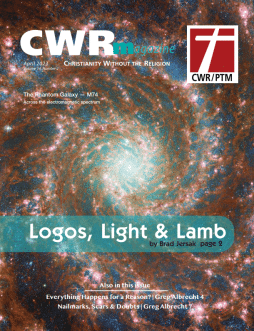Logos, Light & Lamb – Brad Jersak
THE LOGOS (WORD) OF GOD
In the beginning was the Word [Logos]. The Word was with God, and the Word was God. The Word was with God in the beginning. All things came into existence through him; not one thing that exists came into existence without him (John 1:1-3, NTE).
John the Beloved opens his beautiful Gospel with an echo of the Jewish creation story: “In the beginning, God created the heavens and the earth” (Genesis 1:1). It’s important to note that “beginning” here means far more than “first” or “at the start.” This beginning is like laying a foundation on which everything is built and remains, or like an overture that recurs through an entire musical score.
Early Christian teachers would proclaim that this beginning, this foundation, this overture is (not just was) the very Word of God (Jesus Christ) by whom God spoke and speaks all things into being. Origen, for example, paraphrased the first verse of Genesis, “In Christ, God created the invisible and visible universe.” He had learned this from the prologue of John’s Gospel—the Logos (the divine Word), the Son of God, Jesus Christ founded and fashions all of existence. Everything that exists—including you and me—lives and exists in Christ. To call Jesus “the Word of God” is to say (a) Jesus is what God has to say about himself, and (b) this same Christ is the Word who said in Genesis 1 (and says today), “Let there be Light…”
The key point here is that the one true Creator God speaks all that is into being by his Word (Logos), and that Word is none other than our Lord Jesus Christ. Of course, the apostle Paul concurs:
The Son is the image of the invisible God, the firstborn over all creation. For in him all things were created: things in heaven and on earth, visible and invisible, whether thrones or powers or rulers or authorities; all things have been created through him and for him. He is before all things, and in him all things hold together (Colossians 1:15-17, NIV).
THE LIGHT OF THE WORLD
Life was in him, and this life was the Light of the human race. The Light shines in the darkness, and the darkness did not overcome it. There was a man called John, who was sent from God. He came as evidence, to be a witness for the Light, so that everyone might believe through him. He was not himself the Light, but he came to give evidence about the Light. The true Light, which gives light to every human being, was coming into the world. He was in the world, and the world was made through him, and the world did not know him (John 1:4-10, NTE).
Many religions conceive of the Creator as transcendent, outside of creation, beyond time and space—and this is true. Later in John 1, we read that “no one has seen God at any time” (verse 18). So too, Paul writes that God “lives in unapproachable light, whom no man has ever seen or can see” (1 Timothy 6:16, NIV).
But these truths are not true by themselves, for “the one and only Son, who is himself God and is in closest relationship with (lit., in the bosom of) the Father, has made him known” (John 1:18). In Christ, God the Word “pitched his tent” with us and we beheld his glory (John 1:14, see 1 John 1:1-4).
Yes, God is transcendent, but in Christ, he is also immanent. God’s immanence means that he is not far and, in fact, he’s even much more than near! God is everywhere present and fills all things. God-in-Christ-by-the-Spirit (the Holy Trinity) is both beyond creation and united to it, and actually permeates it with his infinite loving presence.
To impress this upon the reader, John describes Jesus Christ as LIGHT. Let’s imagine it this way: the Sun is 96 million miles away from the earth (incredibly far) but at the speed of light, it’s just over eight minutes away (surprisingly close). Despite its vast distance, we can experience the light and heat of the sun directly, even burning our skin, blinding our eyes, or charging the cells of our body.
How much more has God (the unapproachable Light) entered our world (John 1:9), overcome the darkness (vs. 5), and shone his Love on every last one of us (vs. 9). His “life was the Light of the human race” (vs. 4), including those not ready to receive him (vs. 10). Jesus Christ truly is “the Light of the world,” and not just a human subset of well-behaved Christians.
Just as Jesus the Logos (Word) shows us God the Creator, so Jesus the visible Light shows us God the invisible Light, revealing that God the Father is not at all distant. We might use the James Webb telescope by way of limited analogy. The Webb telescope has been generating beautiful images of galaxies and nebulae, transposing frequencies of invisible light into photographs—it is making visible what is truly there, but beyond the spectrum of human vision. If the limited vision of our eyes can’t see it, is the image still “real”? Absolutely.
How much more is Christ the true “image of the invisible God,” unveiling God before the eyes of those who could never otherwise see who God is or what God is like!
THE LAMB OF GOD
When Christ tore back the veil to reveal God’s true nature, we saw a new kind of glory that not one person ever expected (despite the prophetic hints). Here was God—not the roaring lion or soaring eagle
or charging stallion, but a Lamb. A slain Lamb! The baby sheep, killed and eaten at Passover.











 Plain Truth Ministries | Box 300 | Pasadena, CA 91129-0300
Plain Truth Ministries | Box 300 | Pasadena, CA 91129-0300

